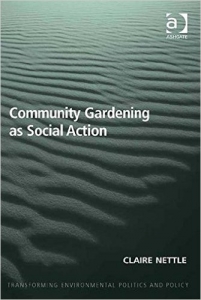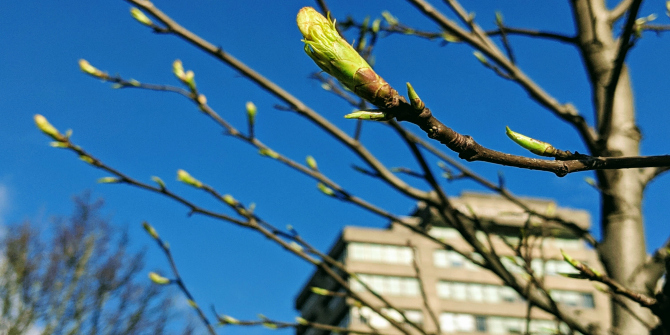 In Community Gardening as Social Action, Claire Nettle looks to provides a new understanding of community gardening by applying a contextual framework that considers the activity as a way for people to engage in collective social action. Carole O’Reilly finds that the book speaks to the broad themes of the collective use of public space, community engagement, and mutual support. In an era when more urban dwellers are turning their attention to these issues, post-recession, this work makes a timely and refreshing contribution.
In Community Gardening as Social Action, Claire Nettle looks to provides a new understanding of community gardening by applying a contextual framework that considers the activity as a way for people to engage in collective social action. Carole O’Reilly finds that the book speaks to the broad themes of the collective use of public space, community engagement, and mutual support. In an era when more urban dwellers are turning their attention to these issues, post-recession, this work makes a timely and refreshing contribution.
Community Gardening as Social Action. Claire Nettle. Ashgate. May 2014.
Find this book (affiliate link): ![]()
 There has been a resurgence of interest in gardening from academics recently – from Lisa Taylor’s A Taste for Gardening (2008) to George McKay’s Radical Gardening (2011) and Clare Hickman’s Therapeutic Landscapes (2013). Claire Nettle’s contribution, Community Gardening as Social Action, marks another welcome addition to this growing area of study. Nettle, a community food systems researcher and consultant, aims to examine the social and political role of community gardens in Australia from a social movement standpoint.
There has been a resurgence of interest in gardening from academics recently – from Lisa Taylor’s A Taste for Gardening (2008) to George McKay’s Radical Gardening (2011) and Clare Hickman’s Therapeutic Landscapes (2013). Claire Nettle’s contribution, Community Gardening as Social Action, marks another welcome addition to this growing area of study. Nettle, a community food systems researcher and consultant, aims to examine the social and political role of community gardens in Australia from a social movement standpoint.
The book begins by presenting community gardens not just as spaces for growing food but as places ‘where people come together to make things happen’ (p. 1). The focus is on three case studies: Northey Street City Farm, a community garden in Brisbane; Cultivating Community, an organisation that supports community gardening at city level; and the Australian City Farms and Community Gardens Network, a national community gardening organisation. The empirical evidence is drawn from Nettle’s own visits to over 60 community gardens and interviews with those directly involved with this activity. The overall aim is to understand community gardens as sites of collective social action.
The book is organised thematically, with chapters on collective action, social movement theory, gardens as producers of community, and growing culture. All are based on a firm grounding in relevant academic literature and on material from interviews with community gardeners. Chapter 3 examines the need to understand community gardening as collective social action and successfully dismantles the traditional association of social movement theory with popular protest. Nettle argues that community gardens can also be read as social movements if we de-emphasise protest and shift the focus onto these gardens as cultural innovators. This move from the political aspects of social movements to their cultural significance provides for a stimulating discussion of the role of community gardens as arenas of creativity.
Further chapters suggest that commitment to community gardening and community building go hand-in-hand and their unique collective management offers an eclectic alternative to urban capitalism for the production of food, for example. The remark about the active nature of these gardens compared to other, more passive forms of public space such as parks, falls a little flat, however. Chapter 6 centres on the community-building role of community gardens and illustrates this with strong evidence from the gardeners themselves. The relationship between good citizenship and community gardening is the focus here and the two concepts are discussed and examined skilfully. The qualitative approach to defining community is persuasive and the discourse of inclusion intrinsic to community gardening welcomes the homeless, immigrants, and those with disabilities, illustrating both the challenges and benefits of these spaces. The determination of those involved with community gardens such as the Northey Street City Farm to confront and resolve issues and problems through consensus and the use of the ‘gardeners’ agreement’ to preserve harmony is a fascinating part of the examination of the difficulties of the collective management of these spaces.

Image Credit: Photo by David Clode on Unsplash
The most insightful chapters of the book are those that privilege the voices of the community gardeners themselves. Reading their articulations of their experiences and motivations provides an opportunity to reveal the hopes, values, and priorities inherent in any form of collective action. Nettle is careful throughout the book not to sentimentalise community gardening or to imbue it with the ability to heal social inequalities and divisions. She remains acutely aware of the dangers of assuming that such collective practices are unproblematic or an ideal solution to the problems confronting Australian cities in the twenty-first century. The community gardens, in this context then, represent the possibility of an alternative practice that can challenge the centrality of the state.
Overall, the writing is fluent and readable with only the occasional awkward sentence which has slipped through the editorial net. At times, less quotation from academic literature and more from the community gardeners themselves would be more welcome as their voices really illuminate the issues at stake in this subject. Structurally, the book remains very close to a standard PhD thesis structure, extending to the chapter summaries and the methodological justifications included in the opening chapter, for example. Nettle has provided some interesting and lively first-person accounts of the activity in the gardens although this does sit a little awkwardly with the more academic writing that predominates in the book. There are no maps or plans of the gardens and not as many photographs as might be expected for a subject such as this one.
The focus on Australian practice is welcome and there are some useful contrasts and parallels with both the allotment tradition in Britain and the reclamation of inner-city land more typical in the United States. The book speaks to the broad themes of the collective use of public space, community engagement, and mutual support. In an era when more urban dwellers are turning their attention to these issues, post-recession, this work makes a timely and refreshing contribution.
Note: This review gives the views of the author, and not the position of the LSE Review of Books blog, or of the London School of Economics and Political Science. The LSE RB blog may receive a small commission if you choose to make a purchase through the above Amazon affiliate link. This is entirely independent of the coverage of the book on LSE Review of Books.
Banner image credit: ‘Morning at the community garden’ by Allan Sharp licensed under CC BY SA 2.0.








1 Comments